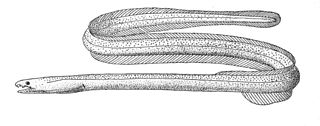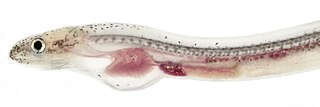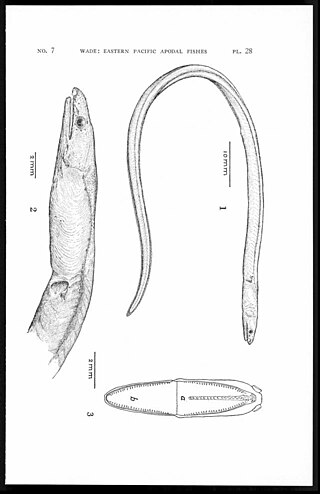
The superorder Elopomorpha contains a variety of types of fishes that range from typical silvery-colored species, such as the tarpons and ladyfishes of the Elopiformes and the bonefishes of the Albuliformes, to the long and slender, smooth-bodied eels of the Anguilliformes. The one characteristic uniting this group of fishes is they all have leptocephalus larvae, which are unique to the Elopomorpha. No other fishes have this type of larvae.

Gymnothorax is a genus of fish in the family Muraenidae found in Atlantic, Indian, and Pacific Oceans. With more than 120 species, it the most speciose genus of moray eels.

Uropterygius is a genus of moray eels in the family Muraenidae.

Eels are ray-finned fish belonging to the order Anguilliformes, which consists of eight suborders, 20 families, 164 genera, and about 1000 species. Eels undergo considerable development from the early larval stage to the eventual adult stage and are usually predators.

Apterichtus is a genus of fish in the family Ophichthidae. Many of its species are called finless eels.
Bascanichthys is a genus of eels in the snake eel family Ophichthidae. It currently contains the following species:

Brachysomophis is a genus of eels in the snake eel family Ophichthidae.

Callechelys is a genus of eels in the snake eel family Ophichthidae. It currently contains the following fifteen species:
Ichthyapus is a genus of eels in the snake eel family Ophichthidae.

Muraenichthys is a genus of eels in the snake eel family Ophichthidae.

Myrophis is a genus of eels in the snake eel family Ophichthidae.
Neenchelys is a genus of snake eels native to the Indian Ocean and the western Pacific Ocean. All species of Neenchelys have two rather than three preopercular pores, a significant character among many species of ophichthids.

Ophichthus is a genus of eels in the snake eel family Ophichthidae.

Pseudomyrophis is a genus of eels in the snake eel family Ophichthidae. It currently contains the following species:

Scolecenchelys is a genus of eels in the snake eel family Ophichthidae.
Skythrenchelys is a genus of eels in the snake eel family Ophichthidae.
Skythrenchelys macrostoma, also known as the large-mouth angry worm eel, is a species of eel in the family Ophichthidae. It is a marine, tropical eel which is known from the Indo-Pacific Ocean, including Red Sea.

Myrophinae, the worm eels, is a subfamily of ray-finned fishes belonging to the family Ophichthidae, which also includes the snake eels in the subfamily Ophichthinae.
The Taiwanese worm eel is a species of ophichthid fish found in Taiwan. This species is only known from northeastern and southwestern Taiwan. This species is the only member of the genus Sympenchelys.
Pylorobranchus hearstorum, the gigantic worm eel, is a species of marine ray-finned fish belonging to the subfamily Myrophinae, the worm eels, in the family Ophichthidae, which also includes the snake eels. This species is known from a single specimen, the holotype collected from the Verde Island Passage in the Philippines at 13.583-13.575°N, 120.382-120.411°E from a depth between 892 and 966 m. The species was described in 2014 by the American marine biologist John E. McCosker. The specific name honours the friends of McCosker and philanthropists William and Margaret Hearst, who sponsored the expedition the holotype was collected on. This single known specimen of this species had a total length of 121.8 cm (48.0 in).














